7. Getting unstuck.
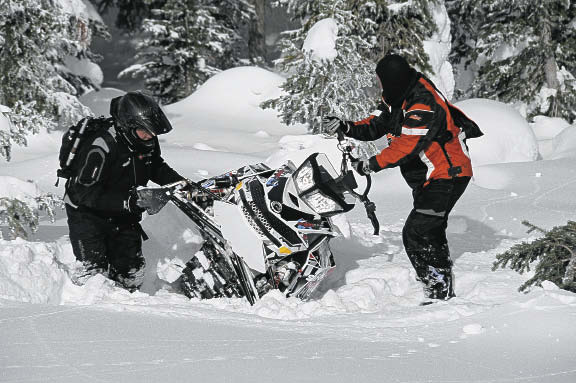
If you ride in the mountains, you're going to get stuck. Those who claim they never get stuck likely never leave the trail. The really talented mountain riders not only get stuck, but usually they get stuck in locations where they are pretty much on their own to get out (the others in the group are likely already stuck farther down the mountain). So if you're trying to improve your riding ability, it's going to make life a lot if you learn how to get out of a jam the easiest way possible.
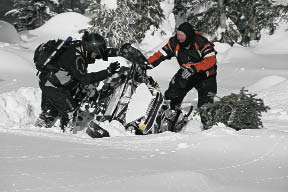 First, take time to assess your situation. Hey, you're stuck. You ain't going anywhere, so figure out your game plan. Are you going to have any help? What's the safest route out? Can you continue moving forward? Sideways? Do you have to go back the way you came? All of these questions will determine your best course of action.
First, take time to assess your situation. Hey, you're stuck. You ain't going anywhere, so figure out your game plan. Are you going to have any help? What's the safest route out? Can you continue moving forward? Sideways? Do you have to go back the way you came? All of these questions will determine your best course of action.
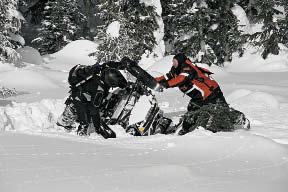 With today's snowmobiles and the traction provided by the deep profile tracks, the dynamics of being "stuck" have changed somewhat. It used to be that the track couldn't provide enough thrust to propel the weight of the snowmobile through the snow. Although that's still the case, the difference is that the modern track will move a lot more snow. which leads to a lot deeper trench. This results in the snowmobile going from a fairly
With today's snowmobiles and the traction provided by the deep profile tracks, the dynamics of being "stuck" have changed somewhat. It used to be that the track couldn't provide enough thrust to propel the weight of the snowmobile through the snow. Although that's still the case, the difference is that the modern track will move a lot more snow. which leads to a lot deeper trench. This results in the snowmobile going from a fairly
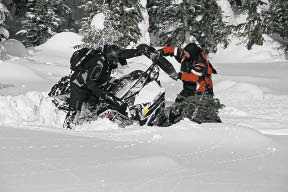 flat position into the snow to a position where the front of the sled could be as much as four feet higher than the rear of the sled. That's a fairly steep grade.
flat position into the snow to a position where the front of the sled could be as much as four feet higher than the rear of the sled. That's a fairly steep grade.
Eventually, as your snowmobile fights to propel itself forward and digs deeper in the snow, certain elements of your sled now begin to work against you. There is likely more drag in the front as it
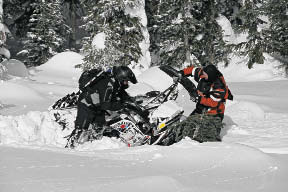 pushes through the powder. But the main culprit is your running boards, which will start to hang up on the edges of your trench. Eventually, even though the track will continue to drop down deeper into the trench, your suspension will run out of travel and your track will literally dangle, not making any more contact to the surface of the snow.
pushes through the powder. But the main culprit is your running boards, which will start to hang up on the edges of your trench. Eventually, even though the track will continue to drop down deeper into the trench, your suspension will run out of travel and your track will literally dangle, not making any more contact to the surface of the snow.
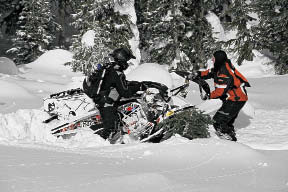 Now, not only are you stuck, but your suspension is fully extended down. To lift your back end out of its trench, you'll likely need a crane. It's not like the good old days when you merely pick up the back bumper and set the sled over on fresh snow. This thing is down, it's wedged and it's weighted with 40 additional pounds of snow in the suspension.
Now, not only are you stuck, but your suspension is fully extended down. To lift your back end out of its trench, you'll likely need a crane. It's not like the good old days when you merely pick up the back bumper and set the sled over on fresh snow. This thing is down, it's wedged and it's weighted with 40 additional pounds of snow in the suspension.
So what do you do?
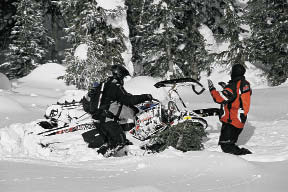 First, take a walk. Literally. Walk around your sled. This not only gives you a moment to establish your game plan, but it also allows you to catch your breath and pack some snow down. And depending on how the base is, you can also figure out what you can or can't do.
First, take a walk. Literally. Walk around your sled. This not only gives you a moment to establish your game plan, but it also allows you to catch your breath and pack some snow down. And depending on how the base is, you can also figure out what you can or can't do.
The first choice of action is always to have someone pull on your front ski. Just the added help getting out of a hole can go a long way. First, however, you need to make certain you're heading out in a level or slightly downhill direction. This may require you to pull the front of the sled around. Keep in mind, if your track is in a hole, it will be fighting with you (pushing against the snow both in the direction you're pulling and the direction it's pushing) every step of the way. That's why it was important to start walking around your sled. If you compact the snow down to the level of the bottom of the track, there will be no counter resistance as the track pivots around.
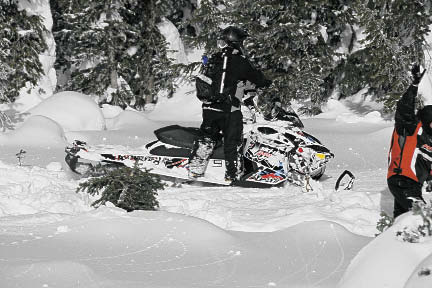 Another way to eliminate some of the resistance is to work your throttle as the front end is pulled around. The advantage of this is that a moving track acts almost like a chain saw cutting away all resistant snow. The track won't wedge if it's spinning as you pull it sideways around. Just be careful to "work" the throttle. There are times to be on the gas and times to be off the gas. You don't want to be digging deeper as much as you just want to cut away the sideway resistance.
Another way to eliminate some of the resistance is to work your throttle as the front end is pulled around. The advantage of this is that a moving track acts almost like a chain saw cutting away all resistant snow. The track won't wedge if it's spinning as you pull it sideways around. Just be careful to "work" the throttle. There are times to be on the gas and times to be off the gas. You don't want to be digging deeper as much as you just want to cut away the sideway resistance.
Also, this is a perfect situation for the use of a Snobunjie. Frankly, when a person tries to pull on the ski to get a sled out of a hole, you run out of arm pull before you run out of hole. A Snobunje offers about three times the length of an arm pull, which is usually enough to get the sled popped out of its hole.
A second way to get unstuck is to completely roll your sled over. Depending on the depth of the hole and the degree of the slope, this can be relatively easy. It's a matter of getting on the high side of the sled, pushing it on its side and then letting it roll all the way over. (Don't worry about your windshield, handlebars or hood if you're in deep snow. Nothing is going to break. But if you are still slightly concerned, then just pop the windshield off.) The advantages of rolling your sled over are that as it rolls, the shape of the sled causes it to literally spin around so the front ends up facing sideways or downhill. You've also managed to pack the snow with the roll so your track is on top of packed snow facing downhill. You are no longer stuck. But before you fire it up and take off, take just a moment to check your throttle and brake to make certain they are free of snow.
The only concern about rolling a sled over would be if you are on a severe slope there is a chance that once it rolls once, it will continue its momentum and roll again, and again, and again. Make sure you can stop it after its initial roll.
Finally, the last option for getting unstuck is shoveling (which is possibly the easiest option when it comes right down to things). The biggest challenge with using your shovel is where you put the snow. If you're on a slope, you can throw the snow downhill. But the first two options of pulling ski or rolling sled tend to make more sense.
The nice part of shoveling is that you can clean the snow away from your sled quickly so you don't have to fight with it. And if you're by yourself, taking the time to use your shovel may save you the most effort and keep you the driest in the long haul.
Other tips for getting unstuck: 1) If you feel your sled losing its momentum as you climb, try to turn out of the slope before you lose it altogether. If you're not on a steep slope and still feel like you're losing your momentum (this can happen in really deep powder even on the slightest of hills) and you know you're not going to make it, grab a fistful of throttle and push off your sled. Sometimes just eliminating your body weight while your track is spinning will allow your sled to crawl back on top of the snow. You're likely still going to be stuck, but you won't be in such a deep hole. 2) Clear the snow from in front of the sled and stomp it down under the nose and back to the front of the track. This eliminates the severity of climbing out of a hole and also puts packed snow down under the base of the track. 3) When you're working the throttle to climb out of a hole, don't "spin" the track down. You need to give your sled enough throttle to make the track engage, but you don't want it to hit so hard that it breaks the grip. 4) Wiggle. It's that simple. Rock your sled from side to side as you crawl out of a hole. This helps compact the base while keeping your running boards from high-centering. 5) Once you start to move, keep your momentum. Get out of the hole and onto an old track set where you are safe to stop. And once you're out and safe, take a moment to cool down and catch your breath. Too often a person gets stuck, gets out and gets stuck again because he was either too tired or impatient.
Too often we get ourselves stuck by doing stupid things like stopping in fresh powder and pointing slightly uphill. Always try to park on either level ground or facing slightly downhill. It's also smart to park on a set of tracks. That may mean making a small circle so you can park in your own tracks when riding in fresh powder. Just a little prevention will save a lot of work.